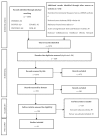Data Collection Instruments for Obesogenic Environments in Adults: A Scoping Review
- PMID: 31010209
- PMCID: PMC6518267
- DOI: 10.3390/ijerph16081414
Data Collection Instruments for Obesogenic Environments in Adults: A Scoping Review
Abstract
The rise in obesity prevalence has increased research interest in the obesogenic environment and its influence on excess weight. The aim of the present study was to review and map data collection instruments for obesogenic environments in adults in order to provide an overview of the existing evidence and enable comparisons. Through the scoping review method, different databases and webpages were searched between January 1997 and May 2018. Instruments were included if they targeted adults. The documents were categorised as food environment or built environment. In terms of results, 92 instruments were found: 46 instruments measuring the food environment, 42 measuring the built environment, and 4 that characterised both environments. Numerous diverse instruments have been developed to characterise the obesogenic environment, and some of them have been developed based on existing ones; however, most of them have not been validated and there is very little similarity between them, hindering comparison of the results obtained. In addition, most of them were developed and used in the United States and were written in English. In conclusion, there is a need for a robust instrument, improving or combining existing ones, for use within and across countries, and more sophisticated study designs where the environment is contemplated in an interdisciplinary approach.
Keywords: adult; built environment; environment; food environment; measurement; obesity; surveys and questionnaires.
Conflict of interest statement
The authors declare no conflict of interest.
Figures
Similar articles
-
Cultural Adaptation and Evaluation of the Perceived Nutrition Environment Measures Survey to the Mediterranean Spanish Context (NEMS-P-MED).Nutrients. 2020 Oct 24;12(11):3257. doi: 10.3390/nu12113257. Nutrients. 2020. PMID: 33114384 Free PMC article.
-
Beyond the black stump: rapid reviews of health research issues affecting regional, rural and remote Australia.Med J Aust. 2020 Dec;213 Suppl 11:S3-S32.e1. doi: 10.5694/mja2.50881. Med J Aust. 2020. PMID: 33314144
-
Development and evaluation of a food environment survey in three urban environments of Kunming, China.BMC Public Health. 2014 Mar 6;14:235. doi: 10.1186/1471-2458-14-235. BMC Public Health. 2014. PMID: 24602326 Free PMC article.
-
Associations between the built environment and obesity: an umbrella review.Int J Health Geogr. 2021 Feb 1;20(1):7. doi: 10.1186/s12942-021-00260-6. Int J Health Geogr. 2021. PMID: 33526041 Free PMC article.
-
Development of physical activity and food built environment quality indicators for chronic diseases in Argentina.Health Promot Int. 2021 Dec 23;36(6):1554-1565. doi: 10.1093/heapro/daaa138. Health Promot Int. 2021. PMID: 33608705 Review.
Cited by
-
Instruments for assessing organisational food environments of workplaces: a scoping review.Public Health Nutr. 2025 Apr 14;28(1):e91. doi: 10.1017/S1368980025000576. Public Health Nutr. 2025. PMID: 40223579 Free PMC article.
-
Neighbourhood socioeconomic disadvantage and body size in Australia's capital cities: The contribution of obesogenic environments.PLoS One. 2023 Jan 20;18(1):e0280223. doi: 10.1371/journal.pone.0280223. eCollection 2023. PLoS One. 2023. PMID: 36662685 Free PMC article.
-
University Food Environment Assessment Methods and Their Implications: Protocol for a Systematic Review.JMIR Res Protoc. 2024 Aug 23;13:e54955. doi: 10.2196/54955. JMIR Res Protoc. 2024. PMID: 39178404 Free PMC article.
-
Examining Place-Based Neighborhood Factors in a Multisite Peer-Led Healthy Lifestyle Effectiveness Trial for People with Serious Mental Illness.Int J Environ Res Public Health. 2023 Apr 28;20(9):5679. doi: 10.3390/ijerph20095679. Int J Environ Res Public Health. 2023. PMID: 37174197 Free PMC article.
-
Cultural Adaptation and Evaluation of the Perceived Nutrition Environment Measures Survey to the Mediterranean Spanish Context (NEMS-P-MED).Nutrients. 2020 Oct 24;12(11):3257. doi: 10.3390/nu12113257. Nutrients. 2020. PMID: 33114384 Free PMC article.
References
Publication types
MeSH terms
LinkOut - more resources
Full Text Sources
Medical


